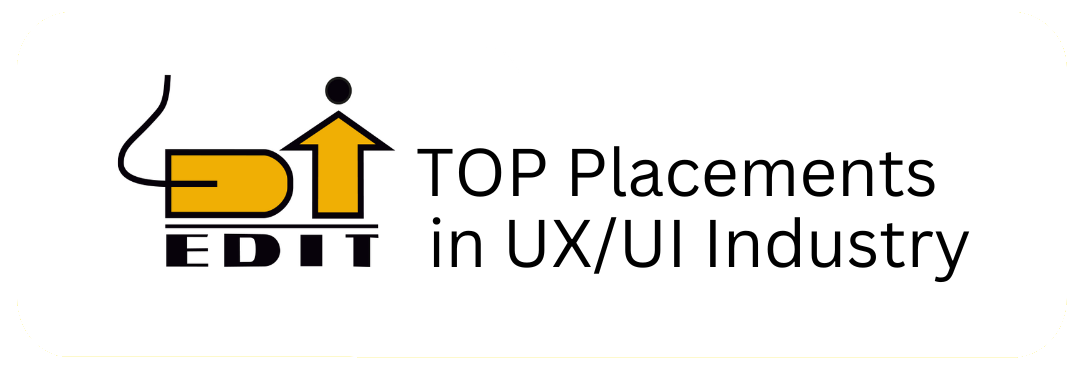UX LENS
News and Tips

Reasons Why UX/UI Design is a Perfect Career for Architects
Reasons Why UX/UI Design is a Perfect Career for Architects?
This is an important question for every architecture student. Apart from this, students should ask the following questions:
- The students pursuing the UX design should ask whether this field excites you?
- Are you comfortable in learning new tools of design?
- Can you afford to take online courses of UX/UI design?
If the answer is yes then explore more, Tips for architects to transit their career into UI/UX
- Online Courses: Check for UX design courses near by me.
- Bootcamps: Intensive boot camps can immerse you in UX design and prepare you for a career shift.
- Books: Read books on UX design to gain a deeper understanding of the field.
- Professional Networking:Connect with UX designers on LinkedIn or attend industry events.
Before delving into benefits of UX/UI , Lets understand the UX/UI design roadmap
What is the UX/UI design road map?
The UX/UI design roadmap typically outlines the steps and milestones involved in creating a user experience (UX) and user interface (UI) for a product or service. It typically includes:
Foundational Knowledge:
- Design Thinking:
This human-centred approach is the cornerstone of UX/UI design. Learn how to understand user needs, empathise with their pain points, and translate those insights into creative solutions.
- User Interface (UI) Design Principles:
Master the fundamentals of visual design, including layout, typography, colour theory, and usability principles. Resources like [Nielsen Norman Group](https://www.nngroup.com/) offer valuable guidance.
- User Experience (UX) Research Methods:
Learn how to conduct user research through interviews, surveys, usability testing, and user persona creation. This will equip you to understand user behaviour and inform your design decisions.
Building Your Skillset:
- Design Tools:
Familiarise yourself with industry-standard design software like Figma, Sketch, and Adobe XD. These tools allow you to create wireframes, mockups, and prototypes to visualise your design ideas.
- Prototyping: Learn how to create interactive prototypes that simulate the user experience. This allows you to test your designs and gather valuable feedback before development begins.
- Information Architecture (IA): Understand how to organize information logically and intuitively. This ensures users can find what they need easily on websites and apps.
Practice Makes Perfect:
- Personal Projects:
The best way to learn is by doing. Design websites or apps for yourself or for friends and family. This allows you to experiment, apply your knowledge, and build a portfolio.
- Take on Freelance Projects:
Look for freelance opportunities on platforms like Upwork or Fiverr. This can give you real-world experience and help you build your client portfolio.
- Participate in Design Challenges:
Many online platforms offer design challenges where you can compete with other aspiring designers. This is a great way to test your skills, receive feedback, and boost your creativity.
Continuous Learning:
- Online Courses:
Numerous online courses and tutorials can further enhance your UX/UI design skills. Platforms like Coursera, Udemy, and Skillshare offer a variety of courses for beginners and experienced designers alike.
- Blogs and Articles:
Stay up-to-date with the latest trends and best practices in UX/UI design by reading industry blogs and articles.
Building Your Network:
- Connect with UX/UI Designers:
Network with other UX/UI designers through online communities, forums, and meetups. This allows you to learn from experienced professionals and get valuable insights into the field.
- Attend Industry Events:
Participate in conferences, workshops, and webinars related to UX/UI design. This is a great way to learn new skills, meet potential employers, and stay ahead of the curve.
- Build an Online Presence:
Create a portfolio website showcasing your design projects and skills. Be active on platforms like LinkedIn and Dribbble to connect with potential employers and showcase your work.
Why is UX/UI design a perfect career for Architects?
Architects and UX/UI designers share a surprising amount of common ground. Both disciplines require creativity, technical expertise, and a deep understanding of user needs. If you’re an architect considering a career shift, UX/UI design might be your perfect landing spot. Here’s why:
The Design Process is Like Building a Second Skin:
- Foundation First:
Just like architects start with a blueprint, UX/UI designers begin with a user research foundation. They understand user needs, behaviours, and pain points.
- Iteration is Key:
Both fields emphasise the iterative process. Architects refine designs based on feedback from engineers and clients. Similarly, UX/UI designers test prototypes with users and iterate based on their input.
- The User is the Client:
In both professions, the end user is paramount. Architects design spaces for people to inhabit, while UX/UI designers craft digital experiences that are user-centred and intuitive.
You Already Speak the Language of Design:
- Visual Communication:
Architects are masters of visual communication, using sketches, 3D models, and renderings to bring their ideas to life. This skillset is useful to UX/UI design, where wireframes, mockups, and prototypes visually communicate design concepts.
- Understanding of User Flow:
Architects meticulously plan the flow of people through a physical space. This translates beautifully to UX/UI design, where user flows map out how users navigate digital interfaces.
- Information Architecture:
Just like architects organise space functionally, UX/UI designers design information architecture. They prioritise content and ensure users can find what they need easily.
Embrace the Challenge of a New Medium:*
The ability for an architect to translate spatial thinking to the digital realm is a valuable asset to a company.
Both UX/UI design and architecture are constantly evolving. New technologies and user needs emerge, requiring designers to adapt and innovate.
A Lucrative and Growing Field:
- User-friendly interfaces need is ever greater due to the advent of internet and social media explosion.
- Companies appreciate architect background students for design thinking, problem-solving abilities, and user-centric approach.
UX/UI Portfolios:
Below are some of our students’ portfolios at the EDIT institute.The students’ academic degrees are from architecture and have exceptionally well in the design area.
Sonia Potdukhe, B.Arch UX designer

Vinaya Dhone B.Arch

So, if you’re an architect seeking a stimulating and rewarding career change, consider exploring UX/UI design. Your existing skill set is a perfect foundation for success in this dynamic and growing field.
Placement of the week

Purva Tatiya-BTech CS
Symphony Tech-UXUI Designer
Stay updated with new designs and build a strong portfolio. I learned a lot about the design process. Understanding the design thinking process was beneficial. It helped me create a portfolio and find suitable opportunities.
Accessibility Audit Tools
Responsive Design Practices
Should I make a career shift from architecture to UX design?
This is an important question for every architecture student. Apart from this, students should ask the following questions:
- The students pursuing the UX design should ask whether this field excites you?
- Are you comfortable in learning new tools of design?
- Can you afford to take online courses of UX/UI design?
If the answer is yes then explore more, Tips for architects to transit their career into UI/UX
- Online Courses: Check for UX design courses near by me.
- Bootcamps: Intensive boot camps can immerse you in UX design and prepare you for a career shift.
- Books: Read books on UX design to gain a deeper understanding of the field.
- Professional Networking: Connect with UX designers on LinkedIn or attend industry events.
Before delving into benefits of UX/UI , Lets understand the UX/UI design roadmap
What is the UX/UI design road map?
The UX/UI design roadmap typically outlines the steps and milestones involved in creating a user experience (UX) and user interface (UI) for a product or service. It typically includes:
Foundational Knowledge:
- Design Thinking:
This human-centred approach is the cornerstone of UX/UI design. Learn how to understand user needs, empathise with their pain points, and translate those insights into creative solutions.
- User Interface (UI) Design Principles:
Master the fundamentals of visual design, including layout, typography, colour theory, and usability principles. Resources like [Nielsen Norman Group](https://www.nngroup.com/) offer valuable guidance.
- User Experience (UX) Research Methods:
Learn how to conduct user research through interviews, surveys, usability testing, and user persona creation. This will equip you to understand user behaviour and inform your design decisions.
Building Your Skillset:
- Design Tools:
Familiarise yourself with industry-standard design software like Figma, Sketch, and Adobe XD. These tools allow you to create wireframes, mockups, and prototypes to visualise your design ideas.
- Prototyping: Learn how to create interactive prototypes that simulate the user experience. This allows you to test your designs and gather valuable feedback before development begins.
- Information Architecture (IA): Understand how to organize information logically and intuitively. This ensures users can find what they need easily on websites and apps.
Practice Makes Perfect:
- Personal Projects:
The best way to learn is by doing. Design websites or apps for yourself or for friends and family. This allows you to experiment, apply your knowledge, and build a portfolio.
- Take on Freelance Projects:
Look for freelance opportunities on platforms like Upwork or Fiverr. This can give you real-world experience and help you build your client portfolio.
- Participate in Design Challenges:
Many online platforms offer design challenges where you can compete with other aspiring designers. This is a great way to test your skills, receive feedback, and boost your creativity.
Continuous Learning:
- Online Courses:
Numerous online courses and tutorials can further enhance your UX/UI design skills. Platforms like Coursera, Udemy, and Skillshare offer a variety of courses for beginners and experienced designers alike.
- Blogs and Articles:
Stay up-to-date with the latest trends and best practices in UX/UI design by reading industry blogs and articles.
Building Your Network:
- Connect with UX/UI Designers:
Network with other UX/UI designers through online communities, forums, and meetups. This allows you to learn from experienced professionals and get valuable insights into the field.
- Attend Industry Events:
Participate in conferences, workshops, and webinars related to UX/UI design. This is a great way to learn new skills, meet potential employers, and stay ahead of the curve.
- Build an Online Presence:
Create a portfolio website showcasing your design projects and skills. Be active on platforms like LinkedIn and Dribbble to connect with potential employers and showcase your work.
Why is UX/UI design a perfect career for Architects?
Architects and UX/UI designers share a surprising amount of common ground. Both disciplines require creativity, technical expertise, and a deep understanding of user needs. If you’re an architect considering a career shift, UX/UI design might be your perfect landing spot. Here’s why:
The Design Process is Like Building a Second Skin:
- Foundation First:
Just like architects start with a blueprint, UX/UI designers begin with a user research foundation. They understand user needs, behaviours, and pain points.
- Iteration is Key:
Both fields emphasise the iterative process. Architects refine designs based on feedback from engineers and clients. Similarly, UX/UI designers test prototypes with users and iterate based on their input.
- The User is the Client:
In both professions, the end user is paramount. Architects design spaces for people to inhabit, while UX/UI designers craft digital experiences that are user-centred and intuitive.
You Already Speak the Language of Design:
- Visual Communication:
Architects are masters of visual communication, using sketches, 3D models, and renderings to bring their ideas to life. This skillset is useful to UX/UI design, where wireframes, mockups, and prototypes visually communicate design concepts.
- Understanding of User Flow:
Architects meticulously plan the flow of people through a physical space. This translates beautifully to UX/UI design, where user flows map out how users navigate digital interfaces.
- Information Architecture:
Just like architects organise space functionally, UX/UI designers design information architecture. They prioritise content and ensure users can find what they need easily.
Embrace the Challenge of a New Medium:*
The ability for an architect to translate spatial thinking to the digital realm is a valuable asset to a company.
Both UX/UI design and architecture are constantly evolving. New technologies and user needs emerge, requiring designers to adapt and innovate.
A Lucrative and Growing Field:
- User-friendly interfaces need is ever greater due to the advent of internet and social media explosion.
- Companies appreciate architect background students for design thinking, problem-solving abilities, and user-centric approach.
UX/UI Portfolios:
Below are some of our students’ portfolios at the EDIT institute.The students’ academic degrees are from architecture and have exceptionally well in the design area.
Sonia Potdukhe, B.Arch UX designer
Reasons Why UX/UI Design is a Perfect Career for Architects
Reasons Why UX/UI Design is a Perfect Career for Architects?
This is an important question for every architecture student. Apart from this, students should ask the following questions:
- The students pursuing the UX design should ask whether this field excites you?
- Are you comfortable in learning new tools of design?
- Can you afford to take online courses of UX/UI design?
If the answer is yes then explore more, Tips for architects to transit their career into UI/UX
- Online Courses: Check for UX design courses near by me.
- Bootcamps: Intensive boot camps can immerse you in UX design and prepare you for a career shift.
- Books: Read books on UX design to gain a deeper understanding of the field.
- Professional Networking:Connect with UX designers on LinkedIn or attend industry events.
Before delving into benefits of UX/UI , Lets understand the UX/UI design roadmap
What is the UX/UI design road map?
The UX/UI design roadmap typically outlines the steps and milestones involved in creating a user experience (UX) and user interface (UI) for a product or service. It typically includes:
Foundational Knowledge:
- Design Thinking:
This human-centred approach is the cornerstone of UX/UI design. Learn how to understand user needs, empathise with their pain points, and translate those insights into creative solutions.
- User Interface (UI) Design Principles:
Master the fundamentals of visual design, including layout, typography, colour theory, and usability principles. Resources like [Nielsen Norman Group](https://www.nngroup.com/) offer valuable guidance.
- User Experience (UX) Research Methods:
Learn how to conduct user research through interviews, surveys, usability testing, and user persona creation. This will equip you to understand user behaviour and inform your design decisions.
Building Your Skillset:
- Design Tools:
Familiarise yourself with industry-standard design software like Figma, Sketch, and Adobe XD. These tools allow you to create wireframes, mockups, and prototypes to visualise your design ideas.
- Prototyping: Learn how to create interactive prototypes that simulate the user experience. This allows you to test your designs and gather valuable feedback before development begins.
- Information Architecture (IA): Understand how to organize information logically and intuitively. This ensures users can find what they need easily on websites and apps.
Practice Makes Perfect:
- Personal Projects:
The best way to learn is by doing. Design websites or apps for yourself or for friends and family. This allows you to experiment, apply your knowledge, and build a portfolio.
- Take on Freelance Projects:
Look for freelance opportunities on platforms like Upwork or Fiverr. This can give you real-world experience and help you build your client portfolio.
- Participate in Design Challenges:
Many online platforms offer design challenges where you can compete with other aspiring designers. This is a great way to test your skills, receive feedback, and boost your creativity.
Continuous Learning:
- Online Courses:
Numerous online courses and tutorials can further enhance your UX/UI design skills. Platforms like Coursera, Udemy, and Skillshare offer a variety of courses for beginners and experienced designers alike.
- Blogs and Articles:
Stay up-to-date with the latest trends and best practices in UX/UI design by reading industry blogs and articles.
Building Your Network:
- Connect with UX/UI Designers:
Network with other UX/UI designers through online communities, forums, and meetups. This allows you to learn from experienced professionals and get valuable insights into the field.
- Attend Industry Events:
Participate in conferences, workshops, and webinars related to UX/UI design. This is a great way to learn new skills, meet potential employers, and stay ahead of the curve.
- Build an Online Presence:
Create a portfolio website showcasing your design projects and skills. Be active on platforms like LinkedIn and Dribbble to connect with potential employers and showcase your work.
Why is UX/UI design a perfect career for Architects?
Architects and UX/UI designers share a surprising amount of common ground. Both disciplines require creativity, technical expertise, and a deep understanding of user needs. If you’re an architect considering a career shift, UX/UI design might be your perfect landing spot. Here’s why:
The Design Process is Like Building a Second Skin:
- Foundation First:
Just like architects start with a blueprint, UX/UI designers begin with a user research foundation. They understand user needs, behaviours, and pain points.
- Iteration is Key:
Both fields emphasise the iterative process. Architects refine designs based on feedback from engineers and clients. Similarly, UX/UI designers test prototypes with users and iterate based on their input.
- The User is the Client:
In both professions, the end user is paramount. Architects design spaces for people to inhabit, while UX/UI designers craft digital experiences that are user-centred and intuitive.
You Already Speak the Language of Design:
- Visual Communication:
Architects are masters of visual communication, using sketches, 3D models, and renderings to bring their ideas to life. This skillset is useful to UX/UI design, where wireframes, mockups, and prototypes visually communicate design concepts.
- Understanding of User Flow:
Architects meticulously plan the flow of people through a physical space. This translates beautifully to UX/UI design, where user flows map out how users navigate digital interfaces.
- Information Architecture:
Just like architects organise space functionally, UX/UI designers design information architecture. They prioritise content and ensure users can find what they need easily.
Embrace the Challenge of a New Medium:*
The ability for an architect to translate spatial thinking to the digital realm is a valuable asset to a company.
Both UX/UI design and architecture are constantly evolving. New technologies and user needs emerge, requiring designers to adapt and innovate.
A Lucrative and Growing Field:
- User-friendly interfaces need is ever greater due to the advent of internet and social media explosion.
- Companies appreciate architect background students for design thinking, problem-solving abilities, and user-centric approach.
UX/UI Portfolios:
Below are some of our students’ portfolios at the EDIT institute.The students’ academic degrees are from architecture and have exceptionally well in the design area.
Sonia Potdukhe, B.Arch UX designer

Vinaya Dhone B.Arch

So, if you’re an architect seeking a stimulating and rewarding career change, consider exploring UX/UI design. Your existing skill set is a perfect foundation for success in this dynamic and growing field.
Accessibility Audit Tools
Placement of the week

Purva Tatiya-BTech CS
Symphony Tech-UXUI Designer
Stay updated with new designs and build a strong portfolio. I learned a lot about the design process. Understanding the design thinking process was beneficial. It helped me create a portfolio and find suitable opportunities.
